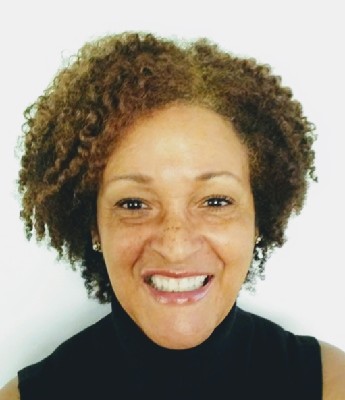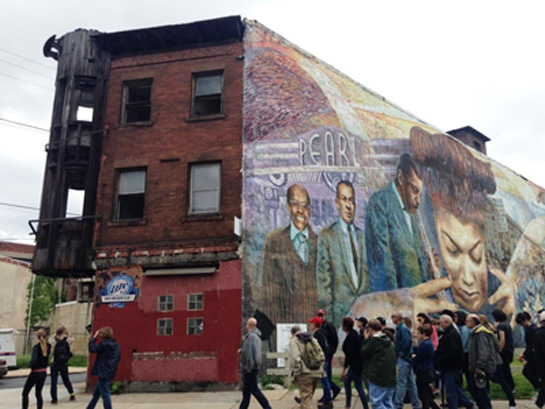Faye Anderson, Director of All That Philly Jazz, Philadelphia, Pennsylvania

Faye Anderson is founder and director of All That Philly Jazz, a place-based public history project that is documenting and contextualizing Philadelphia’s golden age of jazz. The project is at the intersection of art, preservation, and community engagement. She is a graduate of Stanford University and has a Certificate in French Proficiency from Université Cheikh Anta Diop de Dakar, Sénégal.
What led you to your field?
I am a lifelong social justice activist. But I am an “accidental” preservationist. My interest in historic preservation was piqued by the historical marker that notes Billie Holiday “often lived here” when she was in Philadelphia. I went beyond the marker and learned that “here” was the Douglass Hotel. I wanted to know why Lady Day stayed in a modest hotel when a luxury hotel, the Bellevue-Stratford (now the Bellevue Philadelphia), is located just a few blocks away. The Douglass Hotel was first listed in The Negro Motorist Green Book in 1938. The Green Book was a travel guide that helped African Americans navigate Jim Crow laws in the South and racial segregation in the North.
How does what you do relate to historic preservation?
There are few extant buildings associated with Philadelphia’s jazz legacy. In cities across the country, jazz musicians created a cultural identity that was a stepping stone to the Civil Rights Movement. All That Philly Jazz is a crowdsourced project that is documenting untold or under-told stories. At its core, historic preservation is about storytelling. The question then becomes: Whose story gets told? The buildings that are vessels for African American history and culture typically lack architectural significance. While unadorned, the buildings are places where history happened. They connect the past to the present.
Why do you think historic preservation matters?
For me, historic preservation is not solely about brick-and-mortar. I love old buildings. I also love the stories old buildings hold. To borrow a phrase from blues singer Little Milton, if walls could talk, they would tell stories of faith, resistance, and triumph. Historic preservation is about the power of public memory. It’s about staking African Americans’ claim to the American story. A nation preserves the things that matter and black history matters. It is, after all, American history.
What courses do you recommend for students interested in this field?
Historic preservation does not exist in a vacuum. The built environment reflects social inequities. I recommend students take courses that will help them understand systemic racism and how historic preservation perpetuates social inequities. In an essay published earlier this year in The New Yorker, staff writer Casey Cep observed: “To diversify historic preservation, you need to address not just what is preserved but who is preserving it—because, as it turns out, what counts as history has a lot to do with who is doing the counting.”
Places associated with African Americans have been lost to disinvestment, urban planning, gentrification and cultural biases. For instance, the Philadelphia Historical Commission rejected the nomination of the Henry Minton House for listing on the local register despite a unanimous vote by the Committee on Historic Designation. The Commission said the nomination met the criteria for designation but the property is not “recognizable” (read: lacked integrity). Meanwhile, properties in Society Hill with altered or new facades have been added to the local register.
Do you have a favorite preservation project? What about it made it special?
Robert Purvis was a co-founder of the American Anti-Slavery Society, the Library Company of Colored People and the Pennsylvania Anti-Slavery Society. By his own estimate, he helped 9,000 self-emancipated black Americans escape to the North.
The last home in which the abolitionist lived is listed on the Philadelphia Register of Historic Places. The property has had the same owner since 1977. As the Spring Garden neighborhood gentrified, the owner wanted to cash in and sell the property to developers who planned to demolish it. The property is protected, so he pursued demolition by neglect. Over the years, the owner racked up tens of thousands of dollars in housing code violations and fines. In January 2018, the Spring Garden Community Development Corporation petitioned the Common Pleas Court for conservatorship in order to stabilize the property. The petition was granted later that year. A historic landmark that was on the brink of collapse was saved by community intervention.
Can you tell us what you are working on right now?
The John Coltrane House, one of only 67 National Historic Landmarks in Philadelphia, is deteriorating before our eyes. In collaboration with the Preservation Alliance for Greater Philadelphia, Avenging The Ancestors Coalition and Jazz Bridge, I nominated the historic landmark for inclusion on 2020 Preservation At Risk. The nomination was successful. As hoped, the listing garnered media attention. Before the coronavirus lockdown, several people contacted me and expressed interest in buying the property. The conversations are on pause. I am confident that whether under current “ownership” (the owner of record is deceased), new ownership or conservatorship, the rowhouse where Coltrane composed “Giant Steps” and experienced a spiritual awakening will be restored to its former glory.
Do you have advice for novice preservationists?
The professional practice of historic preservation is overwhelmingly white in a country that is projected to be minority white by 2045. The diversity gap is a fundamental barrier to broadening the constituency in support of preservation and increased funding. Preservation is political so go outside the bubble of historic preservation professionals. If preservation is connected to community heritage and struggles for social justice, accidental preservationists will be identified. I am living proof that one does need formal training to be an effective ally and advocate for historic preservation.
The ACHP’s mission is “preserving America’s heritage.” Can you give us an example of how your community is preserving its heritage?

When the Philadelphia Housing Authority announced that it planned to replace 2125 Ridge Avenue with “open space,” i.e., a vacant lot, I used the Section 106 review process to oppose the demolition. PHA was unaware of the cultural significance of the property. However, the community knows it is the former location of the Checker Café (later renamed the Checker Club), a nightspot in the storied Ridge Avenue entertainment district. Opened in 1934, the Checker Café was about intersectionality before the term was coined. The jazz club played host to female impersonators including the “sepia Gloria Swanson.” During the Section 106 review, I documented the property’s association with African Americans who, through their music and sensibilities, helped shape a new fashion and cultural aesthetic. The Advisory Council on Historic Preservation and the State Historic Preservation Officer agreed that the property may be eligible for listing on the National Register of Historic Places. I led a Jane’s Walk along Ridge Avenue during which I announced PHA signed a Programmatic Agreement under which it is required to stabilize the property. The parties to the agreement include the ACHP. I signed as a concurring party.
The ACHP was instrumental in saving a building that has been a visual anchor in the Sharswood neighborhood for more than 100 years and is one of the last vestiges of Philadelphia’s jazz heyday.
How do the arts and social activism play a role in historic preservation?
The narrative in historic preservation is focused on the Founding Fathers and grand architecture. This narrative does not tell the full American story. Art has the power to ignite social change. Think about the instruction to the self-emancipated to “Wade in the Water” to avoid detection, James Weldon Johnson’s “Lift Every Voice and Sing,” Billie Holiday’s “Strange Fruit” and songs of the Civil Rights Movement.
Art provides an emotional connection to a place. On my walking tours, I connect past struggles for freedom and racial justice to contemporary issues such as police misconduct, gentrification and displacement. The ancestors have already done the heavy lifting. I believe to my soul that it is our responsibility to preserve the places that hold our history. In doing so, we will inspire current and future activists.
Read more Q&A stories about the Preservationists in Your Neighborhood!